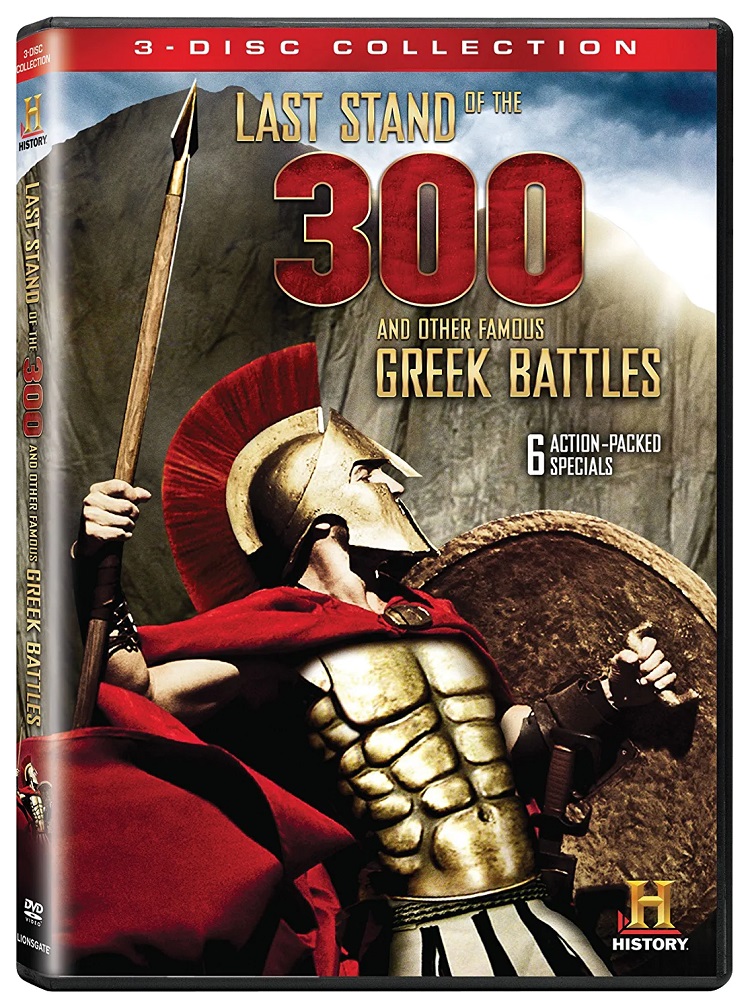
Remember when The History Channel actually showed programs of historical interest? For a lot of people (generally men), those history shows were a welcome diversion from the usual TV fluff. The times have changed dramatically though, for today it is a steady diet of Pawn Stars, Ax Men, and Swamp People.
The Last Stand of the 300 and Other Famous Greek Battles is a reminder of the good old days on HC. This three-DVD contains six History Channel programs about the ancient Greek legends of war, with an emphasis on the 300 Spartans who fought off tens of thousands of Persian warriors in the fourth century BC. The release of the collection has been timed to coincide with the theatrical premiere of 300: Rise of an Empire (2014) on March 7.
The famous 300 Spartans are described as the crème de la crème of Sparta‘s warriors, the equivalent of today’s Navy Seals or the like. But they were joined by around 1,000 other Greeks, because it was understood that all of Greece was at stake. The key was where the Spartans chose to fight, which was the mountain pass Thermopylae. With the mountain on one side and the cliffs on the other, the road was so small that there was just room for a line of just eight men on the front line. In hand to hand combat, the Spartans just plowed through them.
The Persian leader Xerxes’ strategy was to build a giant army, which would overwhelm his opponents by their sheer numbers. Creating an “invincible” individual warrior was not part of the agenda. Their body armor, helmets, and shields were very light, as they were designed to allow the men to travel great distances. The materials were not designed for one-on-one combat, especially against the Greeks, who had heavy duty armor, shields, and spears. In the face off on the small pass, the Spartans tore through the Persian army as if they were paper soldiers. The staggering numbers are 20,000 Persians killed in the first two days, with only a handful of Spartans lost.
It truly was a battle for the ages, for we are still discussing it some 2,400 years after the fact, and the half-hour Decisive Battles: Thermopylae (2004) is focused exclusively on it. The Last Stand of the 300 (2007) tells the other element of the story though. Xerxes realized that his men were stuck on the pass, so he sent out his naval force to get behind the Spartans. The half-hour Decisive Battles: Marathon (2004) tells of how the Athenians battled the Persians where they landed, at Marathon.
The Persian navy was much larger than that of the Athenians, but in the first two days, everything seemed to go the Athenians way, as it had for their comrades in arms, the Spartans. Eventually though, the numbers of the Persian ships did overrun the Athenians, and Xerxes eventually emerged victorious.
In watching this well-chosen collection of programs, we learn that the Persian invasion was retribution for Athens over a slight to Xerxes’ father some 40 years earlier. Battles BC: Judgment Day at Marathon (2009) is an hour-long program describing the earlier battle at Marathon, in which the Persians lost, and were highly embarrassed.
The only thing missing here is the romance angle, and we get that in the one-hour Troy: The Passion of Helen (2004). The Trojan War is another of the immortal Greek engagements, and in this telling of it, we see the events through the eyes of the woman at the heart of it all, Helen of Troy. The final chapter of this entertaining set is Alexander: Lord of War (2009). It is also an hour in length, and in it we follow the Alexander to India. Perception is sometimes everything, and as Alexander learns, deception can be fatal.
The six programs that make up The Last Stand of the 300 and Other Famous Greek Battles have a total running time of over four hours. To make things a little easier, I used the broadcast times for each episode, which did include commercials. A half-hour show is actually around 22 minutes without them.
Based on the title, the set may sound as if it would be strictly for those who have an interest in the military. But I do not believe this to be the case. Oddly enough, I just happened to be reading The Seven Basic Plots by Christopher Booker when I got the set, and the parallels are uncanny. As it turns out, the seven basic plots are all covered in depth in these stories, which is perhaps one reason why we still find them so compelling.
The three-dimensional CGI animation in each of these programs is another notable aspect. Although some of the episodes are now ten years old, the “video game technology” that was used still looks great. It is sort of like watching the guys of Grand Theft Auto at Thermopylae.
The History Channel has changed quite a bit in the past few years, and these shows are a reminder of what they once did so well. Granted, it was kind of a “guys channel“ back in the day. If I remember correctly, Tony Soprano was a big fan. Times change of course, and I am sure that Swamp People are drawing many more viewers than these military reenactments ever did. But by making these shows available in such an inviting collection, those of us who still enjoy this type of programming can easily avail ourselves of it from time to time.